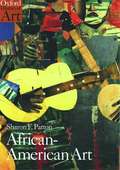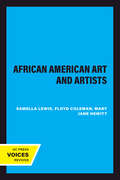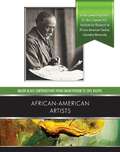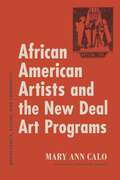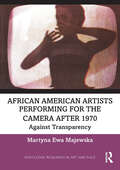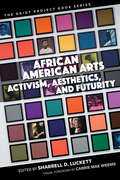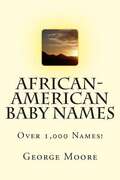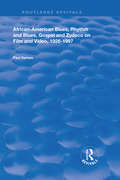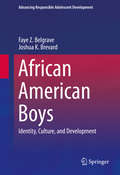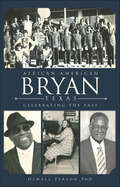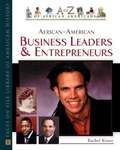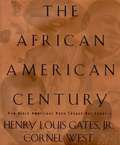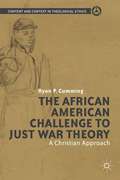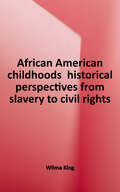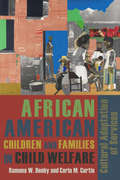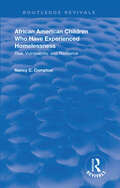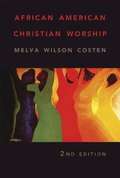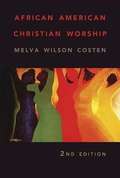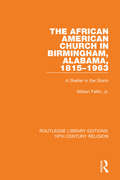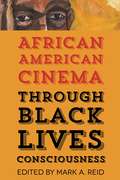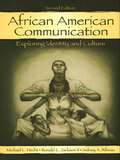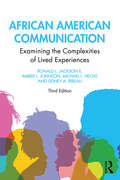- Table View
- List View
African-American Art
by Sharon F. PattonFrom its origins in early 18th century slave communities to the end of the 20th century, African-American art has made a vital contribution to the art of the United States. This book provides a major reassessment of the subject, setting the art in the context of the African-American experience.
African American Art and Artists
by Samella LewisSamella Lewis has brought African American Art and Artists fully up to date in this revised and expanded edition. The book now looks at the works and lives of artists from the eighteenth century to the present, including new work in traditional media as well as in installation art, mixed media, and digital/computer art. Mary Jane Hewitt, an author, curator, and longtime friend of Samella Lewis's, has written an introduction to the new edition. Generously and handsomely illustrated, the book continues to reveal the rich legacy of work by African American artists, whose art is now included in the permanent collections of national and international museums as well as in major private collections.
African American Artists (Major Black Contributions from Emancipat)
by Carol EllisFrom quilts to marble, from comic strips to welded steel, African Americans have created exciting works of art for more than a hundred years. African-American Artists traces the struggles and shows the work of many of these men and women. This book will introduce you to Harriet Powers, who was born a slave and who told legends and stories on her quilts. You'll meet Horace Pippin, who taught himself to paint and kept painting even after he lost the use of his arm. Cartoonist Aaron McGruder and digital artist Angela Perkins are among the African-American artists who continue to enrich the nation's culture today.
African American Artists and the New Deal Art Programs: Opportunity, Access, and Community
by Mary Ann CaloThis book examines the involvement of African American artists in the New Deal art programs of the 1930s. Emphasizing broader issues informed by the uniqueness of Black experience rather than individual artists’ works, Mary Ann Calo makes the case that the revolutionary vision of these federal art projects is best understood in the context of access to opportunity, mediated by the reality of racial segregation.Focusing primarily on the Federal Art Project (FAP) of the Works Progress Administration (WPA), Calo documents African American artists’ participation in community art centers in Harlem, in St. Louis, and throughout the South. She examines the internal workings of the Harlem Artists’ Guild, the Guild’s activities during the 1930s, and its alliances with other groups, such as the Artists’ Union and the National Negro Congress. Calo also explores African American artists’ representation in the exhibitions sponsored by WPA administrators and the critical reception of their work. In doing so, she elucidates the evolving meanings of the terms race, culture, and community in the interwar era. The book concludes with an essay by Jacqueline Francis on Black artists in the early 1940s, after the end of the FAP program.Presenting essential new archival information and important insights into the experiences of Black New Deal artists, this study expands the factual record and positions the cumulative evidence within the landscape of critical race studies. It will be welcomed by art historians and American studies scholars specializing in early twentieth-century race relations.
African American Artists Performing for the Camera After 1970: Against Transparency (Routledge Research in Art and Race)
by Martyna Ewa MajewskaThis study demonstrates how African American artists active since the 1970s have instrumentalized performance for the camera to intervene in existing representations of Black and Brown people in America and beyond.Majewska argues that producing carefully designed photographs, films, and videos via performance became a key strategy for dismantling the conceptions of race and gender fixed by US popular culture, jurisprudence, and pseudoscience. Studying the work of Adrian Piper, Glenn Ligon, Lyle Ashton Harris, Senga Nengudi, Maren Hassinger, Howardena Pindell, David Hammons, and Pope.L, this book examines the ways in which these artists incorporate their bodies and personal experience into their respective performances, simultaneously courting and foreclosing autobiographical readings. The strategies examined here, while diverse, all challenge conventional interpretations of performance art—especially those overdetermined by race, gender, and sexuality.The book will be of interest to scholars working in art history, performance studies, photography, and African American studies.
African American Arts: Activism, Aesthetics, and Futurity (The Griot Project Book Series)
by Sharrell D. Luckett Carmen Gillespie Rikki Byrd Amber Lauren Johnson Doria E. Charlson Florencia V. Cornet Daniel McNeil Lucy Caplan Genevieve Hyacinthe Sammantha McCalla Nettrice R. Gaskins Abby Dobson J. Michael Kinsey Shondrika Moss-Bouldin Julie B. Johnson Jasmine Eileen Coles Tawnya Pettiford-Wates Rickerby HindsSignaling such recent activist and aesthetic concepts in the work of Kara Walker, Childish Gambino, BLM, Janelle Monáe, and Kendrick Lamar, and marking the exit of the Obama Administration and the opening of the National Museum of African American History and Culture, this anthology explores the role of African American arts in shaping the future, and further informing new directions we might take in honoring and protecting the success of African Americans in the U.S. The essays in African American Arts: Activism, Aesthetics, and Futurity engage readers in critical conversations by activists, scholars, and artists reflecting on national and transnational legacies of African American activism as an element of artistic practice, particularly as they concern artistic expression and race relations, and the intersections of creative processes with economic, sociological, and psychological inequalities. Scholars from the fields of communication, theater, queer studies, media studies, performance studies, dance, visual arts, and fashion design, to name a few, collectively ask: What are the connections between African American arts, the work of social justice, and creative processes? If we conceive the arts as critical to the legacy of Black activism in the United States, how can we use that construct to inform our understanding of the complicated intersections of African American activism and aesthetics? How might we as scholars and creative thinkers further employ the arts to envision and shape a verdant society? Contributors: Carrie Mae Weems, Carmen Gillespie, Rikki Byrd, Amber Lauren Johnson, Doria E. Charlson, Florencia V. Cornet, Daniel McNeil, Lucy Caplan, Genevieve Hyacinthe, Sammantha McCalla, Nettrice R. Gaskins, Abby Dobson, J. Michael Kinsey, Shondrika Moss-Bouldin, Julie B. Johnson, Sharrell D. Luckett, Jasmine Eileen Coles, Tawnya Pettiford-Wates, Rickerby Hinds. Published by Bucknell University Press. Distributed worldwide by Rutgers University Press.
African-American Astronauts
by Stanley P. Jones L. Octavia TrippDescribes the lives and accomplishments of five African-American astronauts including Guion S. Bluford Jr., Charles F. Bolden Jr., Frederick D. Gregory, Bernard A. Harris Jr., and Mae C. Jemison.
African-American Aviators
by Stanley P. JonesBriefly describes the lives and accomplishments of five African-American pilots: James Banning, Bessie Coleman, Daniel James, Benjamin Davis, and William Powell.
African-American Baby Names
by George MooreIn this short volume, George Moore discusses the various origins of name-giving practices in the African-American community over the years, from slavery through emancipation, from the Black Power movement and re-connection with African village traditions, real or romanticized, and wonders if parents unintentionally mark their children for failure and rejection by the use of names that are exotic and creative, but sometimes hilariously inappropriate.
African-American Blues, Rhythm and Blues, Gospel and Zydeco on Film and Video, 1924-1997 (Routledge Revivals)
by Paul VernonFirst published in 1999, the main part of this reference consists of an alphabetical listing of many hundreds of artists, with details on band personnel, instrumentation, location, titles performed, sources, and other relevant notes included in each listing.
African American Boys: Identity, Culture, and Development (Advancing Responsible Adolescent Development)
by Faye Z. Belgrave Joshua K. BrevardThis book discusses current research on identity formation, family and peer influences, risk and resilience factors, and concepts of masculinity and sexuality in African American boys. Sorting out genuine findings from popular misconceptions and misleading headlines, this concise and wide-ranging reference covers the crucial adolescent years, ages 11-16, acknowledging diversity of background and experience in the group, and differences and similarities with African American girls as well as with other boys. In addition, the authors review strengths-based school and community programs that harness evidence and insights to promote pro-social behavior. Featured areas of coverage include: The protective role of ethnic identity and racial socialization. Family management, cohesion, communication, and well-being. Development and importance of peer relationships. Health and well-being. Theoretical perspectives on educational achievement. Factors that contribute to delinquency and victimization. What works: effective programs and practices. African American Boys is an essential resource for a wide range of clinicians and practitioners - as well as researchers and graduate students - in school and clinical child psychology, prevention and public health, social work, mental health therapy and counseling, family therapy, and criminal justice.
African American Bryan, Texas: Celebrating the Past (American Heritage)
by Oswell Person PhDBryan was incorporated in 1872, but it would take more than ten years before its African American population was offered schooling. Nothing would come easy for them, but they persevered through hard work, ingenuity and family support. The success of today's generation is a direct result of determined, hardworking pioneers like Dr. Samuel J. Sealey Sr., Bryan's "baby doctor" in the 1930s and '40s, and Dr. William A. Hammond Sr., who opened Bryan's first black hospital and employed many blacks through his business ventures. Learn about the inspiration and guidance provided by the likes of Oliver Wayne Sadberry, an outstanding community leader and principal of Fairview and Washington Elementary. Dr. Oswell Person shares the story of this community's achievements, successes and contributions in the face of incredible odds.
African-American Business Leaders and Entrepreneurs
by Rachel KranzTo fill a gap in US history, an author/documentary film producer specializing in racial issues profiles a broad spectrum of African-American business leaders from the colonial period to the present. Entries are listed by type of business and individual's year of birth. Among the figures featured on the cover are Maggie L. Walker (1867-1934), the first US woman bank president, and Omar Wasow, who created a black-oriented Web site. Annotation ©2004 Book News, Inc., Portland, OR (booknews.com)
The African-American Century: How Black Americans Have Shaped Our Country
by Cornel West Henry Louis Gates Jr.In a highly original and historic celebration of black Americans and their contributions to culture, the authors select 100 outstanding men and women and use their lives and accomplishments to create a fascinating portrait of the last century. Their selections are drawn from the worlds of politics and business, literature, sports, music, science, and cultural criticism. Copyright © Libri GmbH. All rights reserved.
The African American Challenge to Just War Theory
by Ryan P. CummingIn this innovative treatment of the ethics of war, Ryan P. Cumming brings classical sources of just war theory into conversation with African American voices. The result is a new direction in just war thought that challenges dominant interpretations of just war theory by looking to the perspectives of those on the underside of history and politics.
African American Childhoods: Historical Perspectives from Slavery to Civil Rights
by Wilma KingThis text seeks to fill a vacuum in the study of African American children. Recovering the voices or experiences of these children, we observe nuances in their lives based on their legal status, class standing, and social development.
African American Children and Families in Child Welfare: Cultural Adaptation of Services
by Ramona Denby Carla CurtisThis text proposes corrective action to improve the institutional care of African American children and their families, calling attention to the specific needs of this population and the historical, social, and political factors that have shaped its experience within the child welfare system. The authors critique policy and research and suggest culturally targeted program and policy responses for more positive outcomes.
African American Children and Families in Child Welfare
by Ramona Denby Carla M. CurtisThis text proposes corrective action to improve the institutional care of African American children and their families, calling attention to the specific needs of this population and the historical, social, and political factors that have shaped its experience within the child welfare system. The authors critique policy and research and suggest culturally targeted program and policy responses for more positive outcomes.
African American Children Who Have Experienced Homelessness: Risk, Vulnerability, and Resilience
by Nancy C. ComptonFirst published in 1998. While there are ever-increasing numbers of families with young children becoming homeless, little is known about interventions which can promote homeless childrens’ resiliency. This study identifies factors that contribute to homeless children’s positive outcomes. Seventeen African-American children and their mothers were identified through an agency that serves high-risk homeless families. The children were between the ages of three and six-and-a-half.
African American Christian Worship: 2nd Edition
by Melva W. CostenRead a sample In this update to her 1993 classic, African American Christian Worship, Melva Wilson Costen, again delights her reader with a lively history and theology of the African American worship experience. Drawing upon careful scholarship and engaging stories, Dr. Costen details the global impact on African American worship by media, technology, and new musical styles. She expands her discussion of ritual practices in African communities and clarifies some of the ritual use of music in worship. In keeping with recent congregational practices, Dr. Costen will also provide general orders of worship suitable for a variety of denominational settings.
African American Christian Worship (Revised Edition)
by Melva Wilson CostenThis book is a lively history and theology of the African American worship experience. The author details the global impact on African American worship by media, technology, and new musical styles. She expands her discussion of ritual practices in African communities and clarifies some of the ritual use of music in worship.
The African American Church in Birmingham, Alabama, 1815-1963: A Shelter in the Storm (Routledge Library Editions: 19th Century Religion #7)
by Wilson Fallin, Jr.This study, first published in 1997, attempts to fill a gap in the historiography of the African American church by analysing the role and place of the African American church in one city, Birmingham, Alabama. It traces the roles and functions of the church from the arrival of African Americans as slaves in the early 1800s to 1963, the year that the civil rights movement reached a peak in the city. This title will be of interest to students of nineteenth- and twentieth-century religious and social history.
African American Cinema through Black Lives Consciousness
by Dr Melba Joyce Boyd Dr Jonathan Munby Gerald R. Butters Jr. Charlene Regester African American Cinema James Smalls African American Cinema Anne Cremieux African American Cinema Chesya Burke African American Cinema Kimberly Nichele Brown African American Cinema Patricia Hilliard-Nunn African American Cinema Mark D Cunningham African American Cinema Dan Flory Karen Bowdre Mark A. ReidAfrican American Cinema through Black Lives Consciousness uses critical race theory to discuss American films that embrace contemporary issues of race, sexuality, class, and gender. Its linear history chronicles black-oriented narrative film from post–World War II through the presidential administration of Barack Obama. Editor Mark A. Reid has assembled a stellar list of contributors who approach their film analyses as an intersectional practice that combines queer theory, feminism/womanism, and class analytical strategies alongside conventional film history and theory. Taken together, the essays invigorate a "Black Lives Consciousness," which speaks to the value of black bodies that might be traumatized and those bodies that are coming into being-ness through intersectional theoretical analysis and everyday activism. The volume includes essays such as Gerald R. Butters’s, "Blaxploitation Film," which charts the genre and its uses of violence, sex, and misogyny to provoke a realization of other philosophical and sociopolitical themes that concern intersectional praxis. Dan Flory’s "African-American Film Noir" explains the intertextual—fictional and socio-ecological—dynamics of black action films. Melba J. Boyd’s essay, "‘Who’s that Nigga on that Nag?’: Django Unchained and the Return of the Blaxploitation Hero," argues that the film provides cultural and historical insight, "signifies" on blackface stereotypes, and chastises Hollywood cinema’s misrepresentation of slavery. African American Cinema through Black Lives Consciousness embraces varied social experiences within a cinematic Black Lives Consciousness intersectionality. The interdisciplinary quality of the anthology makes it approachable to students and scholars of fields ranging from film to culture to African American studies alike.
African American Communication: Exploring Identity and Culture
by Michael L. Hecht Ronald L. Jackson Sidney A. RibeauWhat communicative experiences are particular to African Americans? How do many African Americans define themselves culturally? How do they perceive intracultural and intercultural communication? These questions are answered in this second edition of African American Communication: Exploring Identity and Culture. Informing multiple audiences interested in African American culture, from cultural researchers and practitioners to educators, policymakers, and community leaders, this innovative and invaluable resource examines the richness and depth of African American communication norms and patterns, as well as African American identities. Positive and healthy African American identities are centrally positioned throughout the book. Applying the cultural contracts theory and the communication theory of identity, authors Michael L. Hecht, Ronald L. Jackson II, and Sidney A. Ribeau explore relationships among African Americans, as well as between African Americans and European Americans, while highlighting the need for sensitivity to issues of power when discussing race, ethnicity, and culture. This wide-ranging volume provides an extensive review of the relevant literature and offers recommendations designed to encourage understanding of African American communication in a context extending beyond Eurocentric paradigms. Considering African American identity with a communicative, linguistic, and relational focus, this volume: *Defines African American identities by describing related terms, such as self, self-concept, personhood and identity; *Explores Afrocentricity and African American discourse; *Examines the status of African Americans in the United States using census statistics and national studies from other research agencies; *Considers identity negotiation and competence; and *Features a full chapter on African American relationships, including gendered, familial, intimate, adolescent and adult, homosexual, friendship, communal, and workplace relationships. African American Communication: Exploring Identity and Culture begins an important dialogue in the communication discipline, intercultural studies, African American studies and other fields concerned with the centrality of culture and communication as it relates to human behavior. It is intended for advanced students and scholars in intercultural communication, interpersonal communication, communication theory, African American/Black studies, social psychology, sociolinguistics, education, and family studies.
African American Communication: Examining the Complexities of Lived Experiences (Routledge Communication Series #Vol. 2)
by Ronald L. Jackson II Amber L. Johnson Michael L. Hecht Sidney A. RibeauNow in its third edition, this text examines how African Americans personally and culturally define themselves and how that definition informs their communication habits, practices, and norms. This edition includes new chapters that highlight discussions of gender and sexuality, intersectional differences, contemporary social movements, and digital and mediated communication. The book is ideally suited for advanced students and scholars in intercultural communication, interpersonal communication, communication theory, African American/Black studies, gender studies, and family studies.
